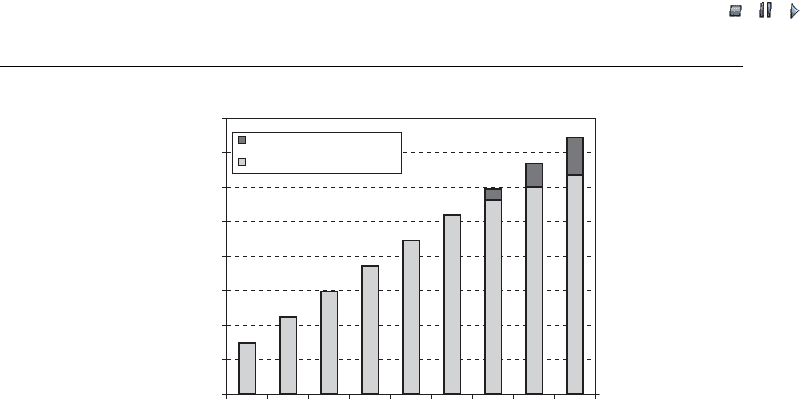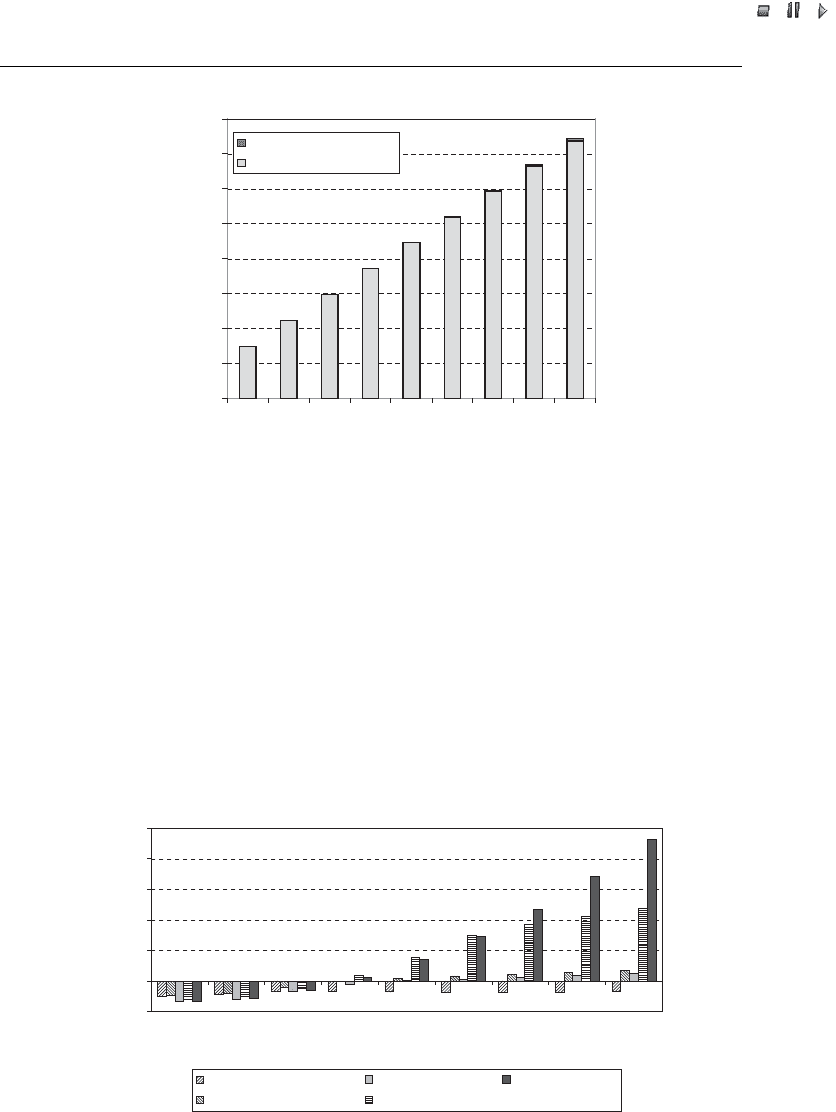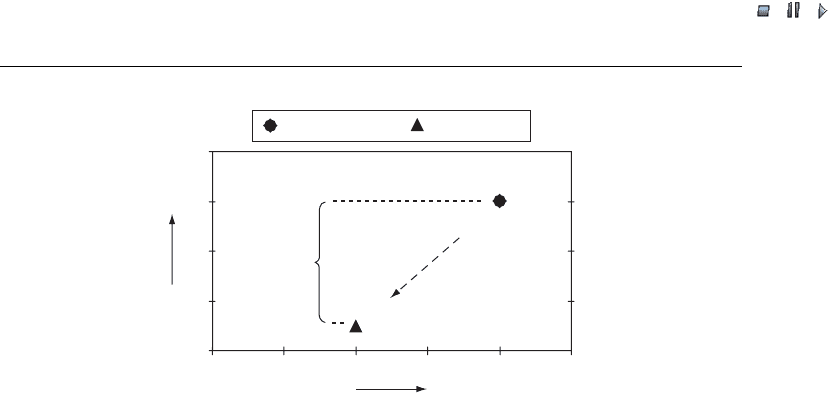AckermannTh. (ed) Wind Power in Power Systems
Подождите немного. Документ загружается.


//INTEGRAS/KCG/P AGIN ATION/ WILEY /WPS /FINALS_1 4-12- 04/0470855088_ 22_CHA21 .3D – 471 – [461–478/18]
17.12.2004 10:44PM
Year-round analysis using the OPF tool shows that penetration levels up to 14 MW
can be achieved with virtually no energy curtailed (for a 14 MW wind farm, only
87 MWh is expected to be curtailed in one year). For a wind farm of 16 MW, the
amount of energy curtailed is 1578 MWh, or 5.3 %. Clearly, area-based voltage control
by OLTC transformers allows a considerable increase in penetration of DG. It is,
however, important to remember that this technique of vo ltage regulation will need
the implementation of a distribution management system (with appropriate commu-
nication systems).
21.3.2.7 Area-based voltage control by on-load tap-changing transformer and voltage
regulator
As indicated in Section 21.3.1, the use of OLTC voltage control in order to reduce the
voltage on the feeder where the generator is connected may produce unacceptable
voltage drops on adjacent feeders that supply loads. The separation of the control of
voltage on feeders that supply load, from the control of voltage on feeders to which the
generators are connected, is achieved by the application of voltage regulators, and this is
investigated in this section.
In order to examine the benefits of this option, a voltage regulator is inserted at the
beginning of the feeder, which accommodates the wind farm. This allows independent
voltage regulation on feeders with loads by the OLTC transformer, while the voltage
regulator controls the voltage on the feeder with the wind farm. In the OPF, the voltage
regulator is modelled in a similar way as an OLTC transformer with the ability to
change the turns ratio from 0.9 p.u. to 1.1 p.u. continuously. The results of this case are
shown in Figure 21.7. It is clear that this voltage control policy increases the amount of
generation that can be connected (up to 20 MW) with almost no curtai led energy.
0
5000
10000
15000
20000
25000
30
000
35000
40000
4 6 8 101214161820
Embedded wind
g
eneration penetration (MW)
Energy (MWh)
Generation curtailed
Net generation
Figure 21.6 Energy generated and curtailed with the application of on-load tap-changing
(OLTC) transformer area-based voltage control
Wind Power in Power Systems 471

//INTEGRAS/KCG/P AGIN ATION/ WILEY /WPS /FINALS_1 4-12- 04/0470855088_ 22_CHA21 .3D – 472 – [461–478/18]
17.12.2004 10:44PM
21.3.2.8 Impact of voltage controls on losses
Connection of distributed generators alters the loss performance of distribution net-
works. A low level of penetration of DG tends to reduce network power flows and thus
network losses. However, when penetration is high then DG will export power to the
grid and may cause increased losses. In this particular system, with no generation being
connected, network losses are 2860 MWh per year. Figure 21.8 shows the change in
network losses for various levels of penetration and various voltage control strategies.
For a low level of penetration, losses are reduced regardless of voltage control. For the
0
5
000
10000
15
000
20000
25
000
30
000
35000
40000
4 6 8 10 12 14 16 18 20
Embedded wind
g
eneration penetration (MW)
Energy (MWh)
Generation curtailed
Net generation
Figure 21.7 Energy generated and curtailed energy from a wind farm over a year, for different
values of wind farm penetration
–500
0
500
1000
1500
2000
2500
4 6 8 101214161820
Embedded wind generation penetration (MW)
Loss (MWh)
Power factor = 0.98
Power factor = 0.95
SVC (3 MVAR)
OLTC
OLTC and VR
Figure 21.8 The losses for different voltage controls and distributed wind generation penetra-
tion. Note: use of static VAR compensator; OLTC ¼ use of on-load tap-changing transformer;
VR ¼ use of voltage regulator
472 Benefits of Active Management of Distribution Systems

//INTEGRAS/KCG/P AGIN ATION/ WILEY /WPS /FINALS_1 4-12- 04/0470855088_ 22_CHA21 .3D – 473 – [461–478/18]
17.12.2004 10:44PM
higher level of penetration, made possible by the application of OLTC transformers and
voltage regulators, losses are signifi cant because of the increased amount of renewable
energy generated.
21.3.2.9 Economic evaluation
The development of DG will depend on governments’ environmental actions, deregula-
tion, novel technologies and economics. Amongst these fact ors, economics are likely to
be decisive for the selection of future technologies and policies. Therefore, an economic
evaluation of DG is indispensable. A cost–benefit analysis (CBA) enables an evaluat ion
and comparison of the cost-effectiveness of projects. Monetary values are placed on
costs and benefits to find out whether the benefits outweigh the costs. The CBA used for
the studies here takes into account: capital costs; operation, maintenance and repair
(OM&R) costs; costs of active management schemes; savings from economies of scale;
and revenue from energy sales and environmental incentives. Based on an assumed
discount rate and a useful plant life time, an evaluation and compari son of net present
values (NPVs) of alternative projects can be carried out. A positive NPV indicates that a
project tends to be profitable.
The overall benefits of the studied active management schemes are summarised in
Figure 21.9 for various levels of DG penetration. The studies performed clearly show
NPV (p.u.)
4
3
2
1
0
468101214161820
Connected DG capacity (MW)
GC, PF = 0.98
GC, PF = 0.95
OLTC
OLTC + VR
SVC (3 MVAR)
Figure 21.9 Comparison of net present values (NPVs) of active management schemes. Note:
NPV of 6 MW care is taken to represent 1 p.u.; DG ¼ distributed generation; GC ¼ generation
curtailment; PF ¼ power factor; SVC ¼ use of static VAR compensator; OLTC ¼ use of on-load
tap-changing transformer; VR ¼ use of voltage regulator
Wind Power in Power Systems 473

//INTEGRAS/KCG/P AGIN ATION/ WILEY /WPS /FINALS_1 4-12- 04/0470855088_ 22_CHA21 .3D – 474 – [461–478/18]
17.12.2004 10:44PM
significant benefits of the use of active control in the distribution network. The most
beneficial are schemes with area-based voltage control by OLTC transformers and
voltage regulators, achieving a threefold increase in the cap acity of DG that can be
connected.
The aim of the economic evaluation was to investigate the optimum combination
of plant capacity and the applied active management scheme. The export capacity of
the plant was varied from 4 MW to 20 MW. Five active management schemes were
studied. Thes e included generation curtailment (GC) with power factors (PFs) 0.98
and 0.95, 3 MVAR reactive compensation, and OLTC transformer voltage control
schemes without voltage regulators (labelled OLTC) and with voltage regulators
(labelled OLTC þVR). The NPVs of all cases studied were calculated. Positive NPVs
represent overall benefit. The NPV of 6 MW DG represents the maximum DG export
capacity that does not require netwo rk reinforcement or active management. It is
therefore taken as the reference, 1 p.u. NPVs greater than 1 p.u. result from increased
income streams that outweigh the costs of active management and additional plant
capacity. Maximum NPVs, as depicted in Figure 21.9, indicate the optimum DG
plant capacity and active management scheme combinations. In this study, all five
active management schemes enable increased energy exports but have different tech-
nical and economic limits:
.
Generation curtailment with a power factor of 0.98: this has its highest NPV at
around 8 MW, but if 13 MW capacity is exceeded it becomes unprofitable.
.
Generation curtailment with a power factor of 0.95: this reaches its highest NPV at
around 10 MW and seems to be profitable up to around 17.5 MW. Note therefore that
higher energy exports are possible at the expense of a decrease in power factor. The
difference between both curves quantifies the financial benefit of a de creased power
factor. The resulting costs such as cost of network losses and charges for reactive
power are not considered in the NPV calculation.
.
Use of SVC (3 MVAR): this shows almost the same characteristic as generation
curtailment with a power factor of 0.95. The benefi t of SVC application in networks
with a higher X/R ratio is expected to be higher than in this example with a relative
low X/R ratio.
.
Use of an OLTC transformer: this scheme has its highest NPV at around 14 MW, but
higher DG capacities, up to 20 MW, are still economically feasible.
.
Use of an OLTC transformer and voltage regulators: benefi t of voltage regulator
application can be perceived in particular for DG capacities exceeding the point of
best performance (14 MW) of the OLTC scheme, being quantified as the difference
between the OLTC and OLTC þ VR curves in Figure 21.9.
To access man y of these benefits new commercial arrangements have to be developed,
and techniques must be established that allow one to determine the positive or negative
contribution of all network participants.
The paradigm shift in energy generation, transmission and distribution will also result
in costs, but it is expected that active management has the potential to reduce these co sts
compared with conventional system reinforcement. The cost of active management
equipment seems often to be lower than the cost for additional transformers, cables
474 Benefits of Active Management of Distribution Systems

//INTEGRAS/KCG/P AGIN ATION/ WILEY /WPS /FINALS_1 4-12- 04/0470855088_ 22_CHA21 .3D – 475 – [461–478/18]
17.12.2004 10:44PM
and overhea d lines. That is why active management control schemes can be a competi-
tive alternative to conventional system reinforcement with regard to mitigating the
voltage-rise effect.
21.3.2.10 The benefits of active management
In this section the benefits of active distribution management have been quantified in
terms of the amount of the additional capacity of DG that can be connected to the
existing distribution system. The benefits of the studied active management control
strategies have been quantified by the volume of annual energy produced and the
corresponding revenue that can be generated for various capacities of wind generation
installed.
However, the added value of the active management of distribution networks is
multifaceted. The benefits of active management are not limited to the facilitation
of higher penetration of DG in existing networks or to the reduction of connection
costs through the maximisation of the use of existing networks. For instance,
energy generated close to demand is considered to have a higher value because of
reduced network losses and avoided utilisation of upstream network assets. Another
potential benefit of active management is the provision of services. It can enable
DG to provide ancillary services (e.g. reactive power management) and provide
network support (contributing to security of supply) to the distribution network.
However, the distribution network operator could provide the service of active
management, to yield higher profits for DG as a result of increased energy output.
The prices and the commercial arrangements for such services are yet to be estab-
lished and therefore they are difficult to value at present. Other benefits of active
management lie in its potential to defer or to reduce investment in distribution
plants (e.g. in voltage control and peak demand shaving). A benefit associated with
reduced investment is a lower risk with respect to stranded assets as a result of
potential load or generation migration. In future, active distribution networks may
enable islanded operation, and this could increase the quality of service delivered by
distribution networks. At present, it is difficult to quantify such benefits of active
management and distributed generation since a considerable amount of judgement
is required.
Value assessment methodologies must be capable of reflecting technical and economic
impacts. One possible approach to identify and quantify the benefit of DG islanding in a
portion of the distribution network normally connected to the grid is a cost–benefit
assessment approach based on the customer outage cost methodology (Kariuki and
Allan, 1996a, 1996b). This approach would assess the value of DG islanding to con-
sumers. The benefit of DG islanding in future active distribution networks can be seen
as offering an improved quality of service to customers. The monetary value of the
improved quality of service can be determined as a reduction in customer outage costs
in a service area. Figure 21.10 shows how reduced system outage durations as a result of
DG islanding results in reduce d customer outage costs. In order for islanding to
be viable, the identified value or benefit must outweigh the costs of making islanded
operation possible.
Wind Power in Power Systems 475

//INTEGRAS/KCG/P AGIN ATION/ WILEY /WPS /FINALS_1 4-12- 04/0470855088_ 22_CHA21 .3D – 476 – [461–478/18]
17.12.2004 10:44PM
21.4 Conclusions
This chapter described the principles of active management of distribution networks.
The main benefits of active management were identified and illustrated in worked
examples. Four active management schemes were studied: (A) use of active power
generation curtailment, (B) use of reactive power management, (C) use of area-based
coordinated volta ge control of OLTC transformers and (D) the application of voltage
regulators. The studies performed clearly showed significant benefits regarding the
active co ntrol of distribution networks. It was shown that a considerable increase in
penetration levels can be achieve d when distributed generators are allowed to absorb
reactive power. The use of OLTC transformer voltage control appears to be most
beneficial as it allows for a large increase in penetration at a low cost, from the primary
plant perspective, but would require more complex control of distribution network
operation. An increase in DG based on these controls would be conditioned by the
operation of an adequate ancillary services market. Further benefits of active manage-
ment were discussed, and one methodology to assess the value of DG islanding was
presented. It can be concluded that the exploitation and assessment of the benefits of
active management often depend on the development of appropriate technical informa-
tion tools and commercial arrangements. These arrangements and frameworks must
consider the requirements of an unbundled electricity industry and must allow the
marketing of such benefits.
References
[1] Bopp, T., Shafiu, A., Chilvers, I., Cobelo, I., Jenkins, N., Strbac, G., Haiyu, L., Crossley, P. (2003)
‘Commercial and Technical Integration of Distributed Generation into Distribution Networks’, presented
at CIRED, 17th International Conference on Electricity Distribution.
[2] Jenkins, N., Allan, R., Crossley, P., Kirschen, D., Strbac, G. (2000) IEE Power and Energy Series: 31.
‘Embedded Generation’, Institute of Electrical Engineers (IEE), London.
[3] Kariuki, K. K., Allan, R. N. (1996a) ‘Evaluation of Reliability Worth and Value of Lost Load’, IEE Proc.
Gener. Transm. Distrib. 143(2) 171–180.
Customer outage costs
Outage duration
Benefit
Without islanding With islanding
Figure 21.10 Reduced customer outage cost resulting from islanding of distributed generation
476 Benefits of Active Management of Distribution Systems

//INTEGRAS/KCG/P AGIN ATION/ WILEY /WPS /FINALS_1 4-12- 04/0470855088_ 22_CHA21 .3D – 477 – [461–478/18]
17.12.2004 10:44PM
[4] Kariuki, K. K., Allan, R. N. (1996b) ‘Application of Customer Outage Costs in System Planning, Design
and Operation’, IEE Proc. Gener. Transm. Distrib. 143(4) 305–312.
[5] Liew, S. N., Strbac, G. (2002) ‘Maximising Penetration of Wind Generation in Existing Distribution
Networks’, IEE Proc. Gener. Transm. Distrb. 149(3) 256–262.
[6] Masters, L., Mutale, J., Strbac, G., Curcic, S., Jenkins, N. (2000) ‘Statistical Evaluation of Voltages in
Distribution Systems with Wind Generation’, IEE Proc. Gen. Trans. Dist 147(4) 207–212.
[7] Saad-Saoud, Z., Lisboa, M., Ekanayake, J., Jenkins, N., Strbac, G. (1998) ‘Application of STATCOM to
Wind Farms’, IEE Proc. C, Gen. Trans. Dist. 145(5) 511–516.
[8] Strbac, G., Jenkins, N., Hird, M., Djapic, P., Nicholson, G. (2002) Integration of Operation of Embedded
Generation and Distributed Networks, UMIST, Manchester, and Econnect, Future Energy Solutions,
publication K/EL/0262/00/00.
Wind Power in Power Systems 477

//INTEGRAS/KCG/P AGIN ATION/ WILEY /WPS /FINALS_1 4-12- 04/0470855088_ 22_CHA21 .3D – 478 – [461–478/18]
17.12.2004 10:44PM

//INTEGRAS/KCG/P AGIN ATION/ WILEY /WPS /FINALS_1 4-12- 04/0470855088_ 23_CHA22 .3D – 479 – [479–504/26]
17.12.2004 10:46PM
22
Transmission Systems for
Offshore Wind Farms
Thomas Ackermann
22.1 Introduction
The interest in the utilisation of offshore wind power is increasing significantly world-
wide. The reason is that the win d speed offshore is potentially higher than onshore,
which leads to a much higher power production. A 10 % increase in wind speed results,
theoretically, in a 30 % increase in power production. The offshore wind power poten-
tial can be considered to be significant. For Europe, the theoretical potential is esti-
mated to lie between 2.8 and 3.2 PWh (Germanischer Loyd, 1998) and up to 8.5 PWh
(Leutz et al., 2001). In addition, countries in central Europe, particularly Germany, are
running out of suitable onshore sites. Some countries promote offshore wind power
because they believe that offshore wind power can play an important role in achieving
national targets for the reduction of emissions of carbon dioxide (CO
2
). However,
investment costs for offshore wind power are much higher than those for onshore
installations. Fortunately, in many central European waters, water depth increases only
slowly with distance from the shore, which is an important economic advantage for the
application of bottom-mounted offshore wind turbines.
Until now, practical experience from offshore wind energy projects is limited (for an
overview of existing projects, see Table 22.1). The installation and supporting structure
of offshore wind turbines is much more expensive than that of onshore turbines. There-
fore offshore wind farms use wind turbines with a high rated capacity ( 1:5MW),
which are particularly designed for high wind speeds. The first offshore projects materi-
alised in Denmark, the Netherlands, Sweden, the United Kingdom and Ireland. Most
existing offshore wind farms tend to be demonstration projects close to the shore.
Wind Power in Power Systems Edited by T. Ackermann
Ó 2005 John Wiley & Sons, Ltd ISBN: 0-470-85508-8 (HB)

//INTEGRAS/KCG/P AGIN ATION/ WILEY /WPS /FINALS_1 4-12- 04/0470855088_ 23_CHA22 .3D – 480 – [479–504/26]
17.12.2004 10:46PM
However, a shift towards large-scale commercial projects has already begun. At the time
of writing, the largest existing projects are the two Danish wind farms: Horns Rev, with
80 2 MW (160 MW) and Nysted, with 72 2:3 MW (165:6 MW).
Further offshore projects are in the planning stage, particularly in Denmark,
Germany (with proposals for a total of 60 GW!), the Netherlands, France, the United
Table 22.1 Offshore wind energy projects, as of 31 January 2003
Name and Location Year No.
turbine
Rated
capacity
(MW)
Total
capacity
(MW)
Hub
height
(m)
Minimum
distance
from
shore (km)
Water
depth
(m)
Nogersund, Sweden
a
1991 1 0.22 0.22 37.5 0.25 6
Vindeby, Baltic Sea,
Denmark
1991 11 0.45 4.95 37.5 1.5 2–5
Lely, Ijsselmeer, The
Netherlands
1994 4 0.5 2 41.5 0.80 5–10
Tunø Knob, Baltic
Sea, Denmark
1995 10 0.5 5 43 6.0 3–5
Irene Vorrink,
Ijsselmeer, The
Netherlands
1996 28 0.6 16.8 50 0.02 1–2
Bockstigen, Baltic
Sea, Sweden
1997 5 0.55 2.75 41.5 4.0 5–6
Lumijoki/Oulu,
Baltic Sea, Finland
1999 1 0.66 0.66 50 0.5 2–3
Utgrunden, Baltic
Sea, Sweden
2000 7 1.425 9.975 65 8.0 7–10
Blyth, North Sea, UK 2000 2 2.0 4 58 1.0 6–9
Middelgrunden Baltic
Sea, Denmark
2001 20 2.0 40 60 2–3 3–6
Yttre Stengrund,
Baltic Sea, Sweden
2001 5 2.0 10 60 5.0 6–10
Horns Rev, Denmark 2002 80 2.0 160 80 14.0 6–12
Frederikshaven,
Baltic Sea, Denmark
2002 2
1
2.3
3
7.6 80 0.5 1
Rønland, Denmark 2002 4 2 17.2 70 0.5 2–3
4 2.3
Samso, Baltic Sea,
Denmark
2003 10 2.3 23 61 3.5 20
Nysted, Baltic Sea,
Denmark
2003 72 2.3 165.6 68 6–10 6–9.5
North Hoyle, UK 2003 30 2.0 60 80 7–8 12
Arklow Bank,
Republic of Ireland
2003 7 3.6 25.2 73.5 10 5–15
a
Decommissioned in 1998.
480 Transmission Systems for Offshore Wind Farms
